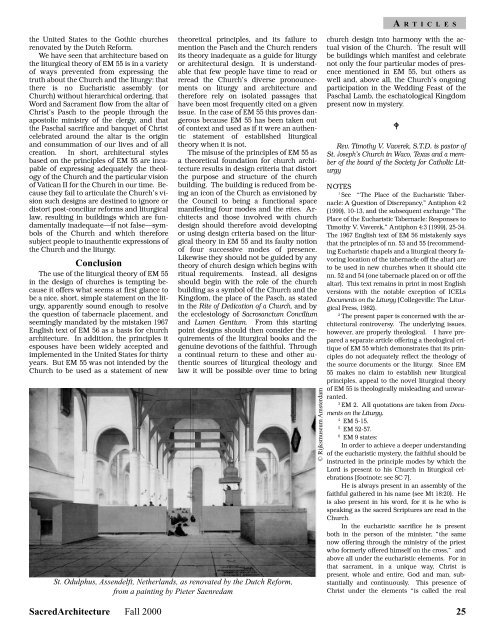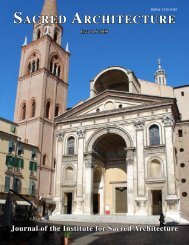Download Issue PDF - The Institute for Sacred Architecture
Download Issue PDF - The Institute for Sacred Architecture
Download Issue PDF - The Institute for Sacred Architecture
- No tags were found...
You also want an ePaper? Increase the reach of your titles
YUMPU automatically turns print PDFs into web optimized ePapers that Google loves.
A R T I C L E Sthe United States to the Gothic churchesrenovated by the Dutch Re<strong>for</strong>m.We have seen that architecture based onthe liturgical theory of EM 55 is in a varietyof ways prevented from expressing thetruth about the Church and the liturgy: thatthere is no Eucharistic assembly (orChurch) without hierarchical ordering, thatWord and Sacrament flow from the altar ofChrist’s Pasch to the people through theapostolic ministry of the clergy, and thatthe Paschal sacrifice and banquet of Christcelebrated around the altar is the originand consummation of our lives and of allcreation. In short, architectural stylesbased on the principles of EM 55 are incapableof expressing adequately the theologyof the Church and the particular visionof Vatican II <strong>for</strong> the Church in our time. Becausethey fail to articulate the Church’s visionsuch designs are destined to ignore ordistort post-conciliar re<strong>for</strong>ms and liturgicallaw, resulting in buildings which are fundamentallyinadequate—if not false—symbolsof the Church and which there<strong>for</strong>esubject people to inauthentic expressions ofthe Church and the liturgy.Conclusion<strong>The</strong> use of the liturgical theory of EM 55in the design of churches is tempting becauseit offers what seems at first glance tobe a nice, short, simple statement on the liturgy,apparently sound enough to resolvethe question of tabernacle placement, andseemingly mandated by the mistaken 1967English text of EM 56 as a basis <strong>for</strong> churcharchitecture. In addition, the principles itespouses have been widely accepted andimplemented in the United States <strong>for</strong> thirtyyears. But EM 55 was not intended by theChurch to be used as a statement of newtheoretical principles, and its failure tomention the Pasch and the Church rendersits theory inadequate as a guide <strong>for</strong> liturgyor architectural design. It is understandablethat few people have time to read orreread the Church’s diverse pronouncementson liturgy and architecture andthere<strong>for</strong>e rely on isolated passages thathave been most frequently cited on a givenissue. In the case of EM 55 this proves dangerousbecause EM 55 has been taken outof context and used as if it were an authenticstatement of established liturgicaltheory when it is not.<strong>The</strong> misuse of the principles of EM 55 asa theoretical foundation <strong>for</strong> church architectureresults in design criteria that distortthe purpose and structure of the churchbuilding. <strong>The</strong> building is reduced from beingan icon of the Church as envisioned bythe Council to being a functional spacemanifesting four modes and the rites. Architectsand those involved with churchdesign should there<strong>for</strong>e avoid developingor using design criteria based on the liturgicaltheory in EM 55 and its faulty notionof four successive modes of presence.Likewise they should not be guided by anytheory of church design which begins withritual requirements. Instead, all designsshould begin with the role of the churchbuilding as a symbol of the Church and theKingdom, the place of the Pasch, as statedin the Rite of Dedication of a Church, and bythe ecclesiology of Sacrosanctum Conciliumand Lumen Gentium. From this startingpoint designs should then consider the requirementsof the liturgical books and thegenuine devotions of the faithful. Througha continual return to these and other authenticsources of liturgical theology andlaw it will be possible over time to bringSt. Odulphus, Assendelft, Netherlands, as renovated by the Dutch Re<strong>for</strong>m,from a painting by Pieter Saenredam© Rijksmuseum Amsterdamchurch design into harmony with the actualvision of the Church. <strong>The</strong> result willbe buildings which manifest and celebratenot only the four particular modes of presencementioned in EM 55, but others aswell and, above all, the Church’s ongoingparticipation in the Wedding Feast of thePaschal Lamb, the eschatological Kingdompresent now in mystery.Rev. Timothy V. Vaverek, S.T.D. is pastor ofSt. Joseph’s Church in Waco, Texas and a memberof the board of the Society <strong>for</strong> Catholic LiturgyNOTES1See “<strong>The</strong> Place of the Eucharistic Tabernacle:A Question of Discrepancy,” Antiphon 4:2(1999), 10-13, and the subsequent exchange ”<strong>The</strong>Place of the Eucharistic Tabernacle: Responses toTimothy V. Vaverek,” Antiphon 4:3 (1999), 25-34.<strong>The</strong> 1967 English text of EM 56 mistakenly saysthat the principles of nn. 53 and 55 (recommendingEucharistic chapels and a liturgical theory favoringlocation of the tabernacle off the altar) areto be used in new churches when it should citenn. 52 and 54 (one tabernacle placed on or off thealtar). This text remains in print in most Englishversions with the notable exception of ICELsDocuments on the Liturgy (Collegeville: <strong>The</strong> LiturgicalPress, 1982).2<strong>The</strong> present paper is concerned with the architecturalcontroversy. <strong>The</strong> underlying issues,however, are properly theological. I have prepareda separate article offering a theological critiqueof EM 55 which demonstrates that its principlesdo not adequately reflect the theology ofthe source documents or the liturgy. Since EM55 makes no claim to establish new liturgicalprinciples, appeal to the novel liturgical theoryof EM 55 is theologically misleading and unwarranted.3EM 2. All quotations are taken from Documentson the Liturgy.4EM 5-15.5EM 52-57.6EM 9 states:In order to achieve a deeper understandingof the eucharistic mystery, the faithful should beinstructed in the principle modes by which theLord is present to his Church in liturgical celebrations[footnote: see SC 7].He is always present in an assembly of thefaithful gathered in his name (see Mt 18:20). Heis also present in his word, <strong>for</strong> it is he who isspeaking as the sacred Scriptures are read in theChurch.In the eucharistic sacrifice he is presentboth in the person of the minister, “the samenow offering through the ministry of the priestwho <strong>for</strong>merly offered himself on the cross,” andabove all under the eucharistic elements. For inthat sacrament, in a unique way, Christ ispresent, whole and entire, God and man, substantiallyand continuously. This presence ofChrist under the elements “is called the real<strong>Sacred</strong><strong>Architecture</strong> Fall 2000 25










